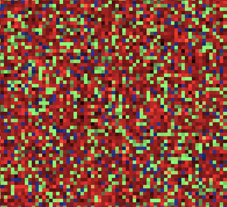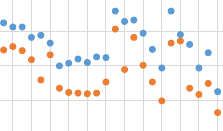
A novel technique for visualizing multispectral images is proposed. Inspired by how prisms work, our method spreads spectral information over a chromatic noise pattern. This is accomplished by populating the pattern with pixels representing each measurement band at a count proportional to its measured intensity. The method is advantageous because it allows for lightweight encoding and visualization of spectral information while maintaining the color appearance of the stimulus. A four alternative forced choice (4AFC) experiment was conducted to validate the method’s information-carrying capacity in displaying metameric stimuli of varying colors and spectral basis functions. The scores ranged from 100% to 20% (less than chance given the 4AFC task), with many conditions falling somewhere in between at statistically significant intervals. Using this data, color and texture difference metrics can be evaluated and optimized to predict the legibility of the visualization technique.

As Machine Vision (MV) and Artificial Intelligence (AI) systems are incorporated to an ever-increasing range of imaging applications, there is a corresponding need for camera measurements that can accurately predict the performance of these systems. At the present time, the standard practice is to separately measure the two major factors, sharpness and noise (or Signal-to-Noise Ratio), along with several additional factors, then to estimate system performance based on a combination of these factors. This estimate is usually based on experience, and is often more of an art than a science. Camera information capacity (C), based on Claude Shannon's ground-breaking work on information theory, holds great promise as a figure of merit for a variety of imaging systems, but it has traditionally been difficult to measure. We describe a new method for measuring camera information capacity that uses the popular slanted-edge test pattern, specified by the ISO 12233:2014/2017 standard. Measuring information capacity requires no extra effort: it essentially comes for free with slanted-edge MTF measurements. C has units of bits per pixel or bits per image for a specified ISO speed and chart contrast, making it easy to compare very different cameras. The new measurement can be used to solve some important problems, such as finding a camera that meets information capacity requirements with a minimum number of pixels, important because fewer pixels mean faster processing as well as lower cost.

Perlin noise, a type of procedural noise, was used for the design of elevation files for 2.5D printing. This printing method uses elevation data from a height map to create physical relief by superimposing layers of ink. In this experiment, the grayscale values of noise functions were used as elevation values to build different surface structures in UV curable ink by 2.5D printing. Printed samples with varying levels of Perlin noise were created and their reflectance properties were studied by measuring the values of specular gloss. The roughness and specular gloss of the printed surfaces were effectively influenced when varying the persistence and octaves of the noise functions. The aim of implementing the procedural approach to a high-resolution printing method has been to explore the reflectance properties of custom noise functions when transferred to the physical realm. This might contribute to better understand the effect of surface structure on the appearance of materials. Potentially, this approach will enable the use of relief printing to produce structures with a more natural appearance and a desired gloss value by using a low-cost computing process.

The Modulation Transfer Function (MTF) and the Noise Power Spectrum (NPS) characterize imaging system sharpness/resolution and noise, respectively. Both measures are based on linear system theory. However, they are applied routinely to scene-dependent systems applying non-linear, content-aware image signal processing. For such systems, MTFs/NPSs are derived inaccurately from traditional test charts containing edges, sinusoids, noise or uniform luminance signals, which are unrepresentative of natural scene signals. The dead leaves test chart delivers improved measurements from scene-dependent systems but still has its limitations. In this article, the authors validate novel scene-and-process-dependent MTF (SPD-MTF) and NPS (SPD-NPS) measures that characterize (i) system performance concerning one scene, (ii) average real-world performance concerning many scenes or (iii) the level of system scene dependency. The authors also derive novel SPD-NPS and SPD-MTF measures using the dead leaves chart. They demonstrate that the proposed measures are robust and preferable for scene-dependent systems to current measures.

With the publication of the second edition of the ISO 15739 Standard [1] in 2013 the measurement of “visual noise” became a normative part of the standard. Over the years the algorithm has proven to be useful and reliable for the judgement of the visibility of noise in images captured by digital cameras. Nevertheless a few aspects of the measurement procedures were questioned by some experts like e.g. the relation of the contrast sensitivity function (csf) for the luminance and the two chrominance channels. And the resulting weighting factors for the three channels also depend on the csf relation. In addition, some experts would like to use the more common CIELAB space instead of CIELUV. For these reasons the responsible ISO technical committee 42 working group 18 is looking into a revision of the visual noise section of the standard. This paper describes the procedure the group is undertaking to solve the remaining issues in the upcoming revision.

Nonlinear complementary metal-oxide semiconductor (CMOS) image sensors (CISs), such as logarithmic (log) and linearâ–”logarithmic (linlog) sensors, achieve high/wide dynamic ranges in single exposures at video frame rates. As with linear CISs, fixed pattern noise (FPN) correction and salt-and-pepper noise (SPN) filtering are required to achieve high image quality. This paper presents a method to generate digital integrated circuits, suitable for any monotonic nonlinear CIS, to correct FPN in hard real time. It also presents a method to generate digital integrated circuits, suitable for any monochromatic nonlinear CIS, to filter SPN in hard real time. The methods are validated by implementing and testing generated circuits using field-programmable gate array (FPGA) tools from both Xilinx and Altera. Generated circuits are shown to be efficient, in terms of logic elements, memory bits, and power consumption. Scalability of the methods to full high-definition (FHD) video processing is also demonstrated. In particular, FPN correction and SPN filtering of over 140 megapixels per second are feasible, in hard real time, irrespective of the degree of nonlinearity. c 2018 Society for Imaging Science and Technology.